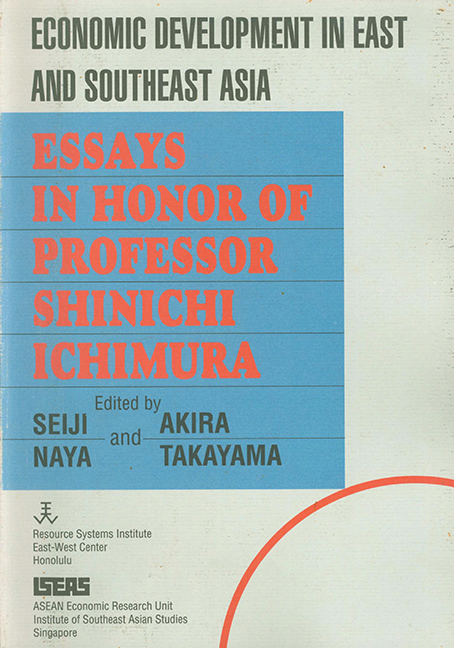Book contents
- Frontmatter
- Preface
- Shinichi Ichimura, 1925-
- CONTENTS
- Introduction
- Contributors to This Volume
- I Structural Change and Economic Development in Developing Asia in the 1990s
- II Explaining the Success of the Four Little Dragons: A Survey
- III Taiwan's Economic Miracle: A Singaporean Perspective
- IV Singapore's Experience of Industrial Restructuring: Lessons for the Other Asian NIEs
- V Korean Industrial Policies for Declining Industries
- VI Vietnam: Recent Economic Developments and the World Economy
- VII Transition from Import Substitution to Export Expansion: The Thai Experience
- VIII Adjustment Problems of a Small Oil-Exporting Country: Did Indonesia Suffer from the Dutch Disease?
- IX A Quarterly Econometric Model of the Hong Kong Economy
- X The Effect ofRicardian Rent Extracting on Macroeconomic Performance
- XI Direct Foreign Investment and the Economic Development of Korea
- XII Japanese Investment in Thailand: Looking Back and Into the Future
- XIII The Effects of Direct Foreign Investment on Taiwan: A Macroeconometric Investigation
- XIV A Reform of the Foward Foreign Exchange Market and Foreign Exchange Rate Determination Policy in Korea, with Foreign Exchange Policy Experiences of Taiwan
- XV Interest Rate and Foreign Exchange Liberalization in Taiwan in the 1980
- XVI Manifold Dilemmas behind External Debt Management
- XVII Agricultural Growth and Food Imports in Developing Countries: A Reexamination
- XVIII The Transformation of Rural Asia and Economic Development Theory and Policy
- XIX The ASEAN Summit and ASEAN Economic Cooperation
- XX The Role of Developing Countries in the New GATT Round
- XXI The Emerging Global Economy and the Role of the Asian NIEs
- Index
XIX - The ASEAN Summit and ASEAN Economic Cooperation
Published online by Cambridge University Press: 21 October 2015
- Frontmatter
- Preface
- Shinichi Ichimura, 1925-
- CONTENTS
- Introduction
- Contributors to This Volume
- I Structural Change and Economic Development in Developing Asia in the 1990s
- II Explaining the Success of the Four Little Dragons: A Survey
- III Taiwan's Economic Miracle: A Singaporean Perspective
- IV Singapore's Experience of Industrial Restructuring: Lessons for the Other Asian NIEs
- V Korean Industrial Policies for Declining Industries
- VI Vietnam: Recent Economic Developments and the World Economy
- VII Transition from Import Substitution to Export Expansion: The Thai Experience
- VIII Adjustment Problems of a Small Oil-Exporting Country: Did Indonesia Suffer from the Dutch Disease?
- IX A Quarterly Econometric Model of the Hong Kong Economy
- X The Effect ofRicardian Rent Extracting on Macroeconomic Performance
- XI Direct Foreign Investment and the Economic Development of Korea
- XII Japanese Investment in Thailand: Looking Back and Into the Future
- XIII The Effects of Direct Foreign Investment on Taiwan: A Macroeconometric Investigation
- XIV A Reform of the Foward Foreign Exchange Market and Foreign Exchange Rate Determination Policy in Korea, with Foreign Exchange Policy Experiences of Taiwan
- XV Interest Rate and Foreign Exchange Liberalization in Taiwan in the 1980
- XVI Manifold Dilemmas behind External Debt Management
- XVII Agricultural Growth and Food Imports in Developing Countries: A Reexamination
- XVIII The Transformation of Rural Asia and Economic Development Theory and Policy
- XIX The ASEAN Summit and ASEAN Economic Cooperation
- XX The Role of Developing Countries in the New GATT Round
- XXI The Emerging Global Economy and the Role of the Asian NIEs
- Index
Summary
Introduction
The heads of governments of the Association of Southeast Asian Nations (ASEAN) — Brunei, Indonesia, Malaysia, the Philippines, Singapore, and Thailand — met in December 1987 at the ASEAN Summit in Manila. The fact that the Summit was not postponed nor moved to another venue and that no untoward incident happened despite the strained and potentially explosive situation in the country was viewed in the Philippines as a distinct signal of political stability. It also gained for the government some degree of political mileage.
However, we should not be distracted from the substance of the Summit meeting where new initiatives, especially for economic cooperation, were considered and approved. After all, the Summit was simply the mechanism for which more innovative schemes to move the ASEAN cooperative spirit forward were launched.
This paper looks into the economic context of the ASEAN Summit and its prospects for regional economic cooperation. Do set the tone for the paper, the relevant framework is examined briefly in the next section. In subsequent sections, previous attempts at economic cooperation in ASEAN and the reasons for their shortcomings are also reviewed, and the Summit proposals for economic cooperation are laid out in general terms. In the final section, the paper concludes with the implications of the Summit proposals and their contribution toward greater ASEAN economic cooperation.
Theory and Tradition
The theoretical rationale behind regional economic integration is the notion in trade theory that a partial move towards freer trade improves welfare among the member nations. The removal or reduction of tariffs among the member countries should improve resource allocation and expand markets. In addition, there is a greater scope for improved efficiency if the countries produce similar products. Thus, whether integration is only beginning, such as in the case of a free trade area, or will move along higher forms (for example, a customs union, a common market, or an economic union), freer trade will be beneficial.
In the theory of the second-best, however, we are warned that not every move towards free trade is welfare-improving (Viner 1950; Lipsey 1960). If integration leads to trade diversion away from efficient sources under a nondiscriminatory situation to an inefficient partner source under the integration scheme, then resource misallocation takes place. If this trade diversion outweighs the trade creation, then integration may not be welfare-improving overall.
- Type
- Chapter
- Information
- Economic Development in East and Southeast AsiaEssays in Honor of Professor Shinichi Ichimura, pp. 299 - 306Publisher: ISEAS–Yusof Ishak InstitutePrint publication year: 1990



